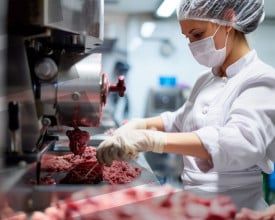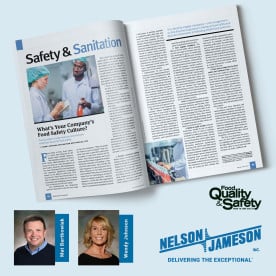Monthly Archives: May 2020
- May 27, 2020
While whipping up a quick dinner recently, I decided to use my handy-dandy microwave to get the rice cooking portion of the meal done. Just below, the thrilling smells of cooking vegetables and fish wafted up as I did my best not to burn what was in the pan in front of me on the stove. Feeling good about my culinary self momentarily, I casually glanced up at the microwave. Torrents of foam cascaded out of the vessel I had put the rice in...in the end, I had cooked rice and a significant starchy mess to clean up. When on top of a freshly poured beer, a healthy level of foam can bring me great joy; in this instance, it brought me back to Earth in terms of thinking about my talents in the kitchen.
Now, take that unfortunate incident and think about a food processing facility producing your favorite products. Foam happens in many food
- May 11, 2020
Selecting the right safety sign is a critical task in maintaining a secure work environment, and several key factors must be considered in this process. OSHA and ANSI regulations mandate that signage effectively communicates and defines specific hazards that pose a risk of injury or even death if left unidentified. One crucial aspect to contemplate is the safety sign header, which specifies the degree of hazard applicable to your situation. Different headers cater to distinct hazard levels, ensuring a clear and accurate indication of potential dangers. Explore the nuances of Danger, Warning, Caution, Notice, and Safety First signs, each serving a unique purpose in conveying the severity of potential hazards. Whether it's an immediate danger with a high probability of severe consequences or a cautionary note about a potentially hazardous situation, understanding the distinctions in safety signage headers is essential for creating a safe and informed workplace.
- May 05, 2020
Saint Augustine is attributed as stating: “We make a ladder for ourselves of our vices, if we trample those same vices underfoot.” Inspiring words...and tangentially,
- May 04, 2020
Selecting the appropriate material for safety signs is a crucial decision, influenced by various factors such as the time of day, temperature, and intended usage. The choice of material significantly impacts the sign's visibility, durability, and overall effectiveness. To assist in making informed decisions, the table below serves as a valuable guide, providing insights into the characteristics and suitability of different materials for specific applications. Whether it's ensuring visibility in low-light conditions, withstanding extreme temperatures, or meeting the demands of particular environments, this guide aids in the thoughtful selection of materials to enhance the overall efficacy of safety signage in diverse settings.
- May 03, 2020
Custom shadow boards offer numerous advantages, contributing to the efficient organization of tools and the enhancement of workplace safety. Aligned with the principles of the 5S methodology—Sort, Set to Order, Shine, Standardize, and Sustain—custom shadow boards play a crucial role in fulfilling these requirements. The choice of material is a pivotal decision, and there are three options available to cater to different purposes: General Purpose Composite, Industrial Grade Aluminum, and Pro Series Acrylic. Each material has distinct features and temperature ranges suitable for various environments. To create a custom shadow board, a step-by-step process is outlined. It begins with selecting the board material, followed by identifying the tools to be shadowed, choosing the title and background color, specifying the board size, and considering additional information like color-coding charts, company name, logo, or images. By following these steps, businesses can tailor their shadow





